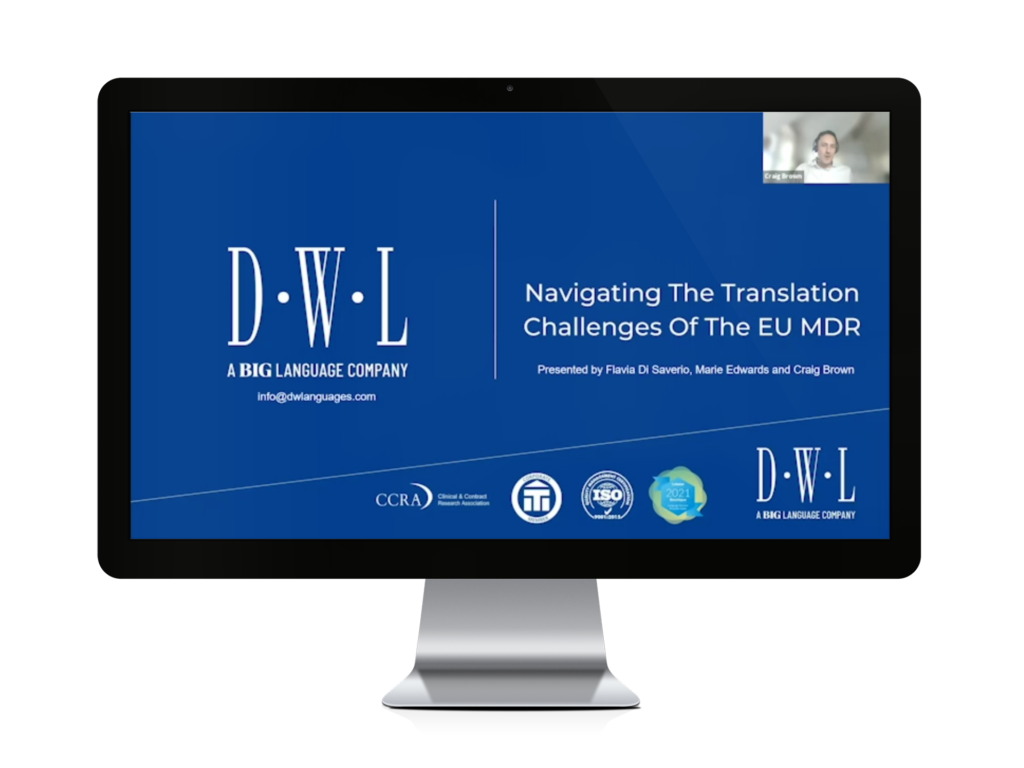Hot on the heels of our blog post about Electronic Product Information (ePI) comes another update on how developments in eConsent can affect the way we interact with health information.
This post focuses on Electronic Informed Consent (eConsent), a topic which is of interest to us as a language service provider (LSP) specialising in translating clinical trial documents in traditional formats.
As is the case with developments in ePI, technology is being deployed to make gathering consent from potential study participants more efficient.
Unlike ePI, eConsent is not destined to be taken up universally across Europe, at least not initially. It will likely be adopted on a case-by-case basis for the time being, and companies like Medidata and Signant Health have both created individual eConsent solutions for the market. As described later in this article, the manner in which you seek consent electronically may be unique to the study design, product or target participant in question.
Of course, eConsent is not without its own challenges, but it looks to have considerable potential to widen the pool of clinical trial participants, as well as to rely less heavily on geographical location. This is of great relevance in light of COVID-19 restrictions, when we are being discouraged from converging unnecessarily in large numbers outside of the home.
What is Informed Consent in clinical trials?
Informed consent is fundamental to the ethics of conducting clinical trials.
After all, the purpose of conducting a clinical trial on a medicinal product is to establish:
- Safety.
- Efficacy.
- Optimum use (dose, route of administration, etc.).
An otherwise healthy participant may be exposed to a medicinal product about which the above are only partially known. A participant must therefore not only be informed about what participation in the trial will involve, but they must also confirm that they understand it.
This includes understanding about:
- what will happen to them during/after the trial
- any risks involved
- there not being any personal benefit following their involvement
- what happens if they leave the trial
- participation on a purely voluntary basis
The full Informed Consent Form (ICF) may consist of many tens of pages about complex and delicate issues, and there is considerable room for error. Documents can become outdated after printing or the opportunity to ask questions may be missed and participants can therefore lose interest, self‑exclude or find themselves ineligible as a result of administrative errors.
The Center for Information and Study on Clinical Research Participation (CISCRP) filed a Report in 2013 on Ineligible Participants and Those Who Terminate Participation Early[1], which included results from a survey of respondents who had dropped out of a clinical study. Of these, 35% reported that it was ‘Somewhat/Very Difficult’ to Understand the Informed Consent Form.
The administrative burden of maintaining the current paper-based system alone can also lead to errors which, in turn, can result in participant ineligibility even if understanding has been achieved and consent given.
It is apparently common for ICFs to be misfiled, lack signatures, be outdated or incorrectly completed in some other way as a result of human error.
The CISCRP report also found that two thirds of study volunteers who fail to qualify for a trial are lost to clinical research temporarily or permanently.
In theory, eConsent can address the issues above by aiding comprehension on the part of the trial participant and reduce administrative issues.
What is eConsent?
The Medicines and Healthcare products Regulatory Agency (MHRA) defines eConsent as:
- The use of any electronic media (such as text, graphics, audio, video, podcast or websites) to convey information related to a study.
- Seeking and/or documenting informed consent via an electronic device such as a smartphone, tablet or computer.
There are thus two angles to this, the first being an opportunity to offer the participant a more varied array of media to understand what is involved in the trial. This could consist of any combination of media listed above, as well as interactive features (such as checkboxes, knowledge checking, flags, etc.) The second is to provide a centralised platform to collect and analyse the signed consent forms and respond to participant queries (or re-consent) efficiently.
Openness to eConsent has risen in recent years at a national and EU level. Most recently during the COVID-19 pandemic, we find ourselves in a situation where, in order for trials to go ahead, informed consent must be gathered on a remote basis while giving participants the best chance to understand and give consent to participate. This could be a good moment to roll-out a method for recruiting and getting consent from participants in an electronic manner.
Opportunities?
The suggestion is that eConsent, as a self-paced, multimedia approach to presenting clinical trial information, will result in better comprehension by trial participants and their families compared to a paper ICF.
Because of the range of media, the content may also be tailored to specific audiences, e.g. a child may watch a video, whereas their parent may read the ICF in a more traditional format. The ability to adapt the medium could hold participants’ attention for longer, which is essential for more complex trials with more information to cover.
The process doesn’t need to be any more complex, however, despite the varied media. The participant may simply read the eConsent documents, alongside any accompanying media, tick each section in order to track progress through the information (flagging anything that requires further explanation) and then ultimately give consent via an electronic signature.
As a result of the above, participants are better informed and Sponsors are less likely to encounter regulatory pushbacks later on for non-compliance.
Instantly available updated information for the participant.
Moving away from a paper-based system means that every participant in a trial receives up-to-date information so that their consent can be maintained throughout, even following a substantial amendment to the protocol.
The electronic aspect of this technology also enables immediate collection of signatures by study coordinators—a positive alternative to the administrative burdens currently placed on study sites to collect and file paper ICFs, and to the errors that may arise from misfiling them.
Access to study information via an electronic portal can enable participants to access their information at any time, but also to be monitored remotely and in real-time by study coordinators. This means that enrolment figures are up-to-the-minute and participant questions can be swiftly answered.
Challenges?
Even though eConsent solves many problems associated with the current paper system, there would seem to be some challenges to be addressed.
For example, there will of course be participants, such as the elderly, who are not receptive to new forms of media, or who are unable to provide an electronic signature.
In these instances, a paper version of the ICF may be read and signed instead, but could this run the risk of two parallel systems during a trial, in which one set of participants is better informed than the other?
Something else to consider is whether there is a ‘best practice’ approach on how to present information about the trial, if not in paper format. Of course the trial must adhere to Good Clinical Practice (GCP) guidelines, but there are many forms of media at the disposal of a study coordinator. Do we need further work to establish how best to inform potential participants about a trial, if not on paper?
A further possible challenge to the eConsent system is participant deception. If consent is being given on a remote basis, then could there be fewer opportunities to detect examples of this?
In a study of deception in experienced research participants entitled “Deception in Clinical Trials and its Impact on Recruitment and Adherence of Study Participants”, one in four of the surveyed participants exaggerated health problems in order to qualify for a trial, and one in three pretended to have health problems, provided false information or inflicted self-harm in order to qualify. Seventy five percent of participants withheld information in order to avoid exclusion[2].
Perhaps there is also an opportunity here to use the multimedia aspect of the eConsent form to overcome deception in trials, and make it clear to potential participants that studies may be invalidated as a result of misinformation.
Providing electronic signatures in lieu of wet-ink signatures could also be seen as a security issue due to the potential for fraud; however, the risk is perhaps minimal since electronic signatures are becoming widely accepted and are presumably preferred at a time when the advice is not to attend hospital settings in person.
Relevance to Translation
LSPs should take note of this development, since it has the potential to change the format in which consent is gathered and information is presented. The information we traditionally translate for clinical trials in MS Word may no longer simply appear on a page.
LSPs are accustomed to translating written ICFs and should already have a robust system in place for monitoring version control of documents. However, if the materials needed to inform a participant span various forms of media, then it will be necessary to ensure that the translated message is consistent across all channels, and similar version control and quality control measures should be applied.
As with all administrative changes of this kind, particularly where participant safety is impacted, DWL will be keeping a close eye on developments.
Don’t hesitate to get in touch if you have any questions about how clinical trial documents are translated, or if you would like to discuss any upcoming requirements you may have.
[1] http://www.medavante-prophase.com/wp-content/uploads/2018/09/2013_ciscrp_study_ineligible_participants_and_those_who_drop_out.pdf
[2] “Deception in Clinical Trials and its Impact on Recruitment and Adherence of Study Participants” https://bit.ly/38zog58






